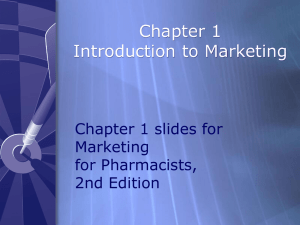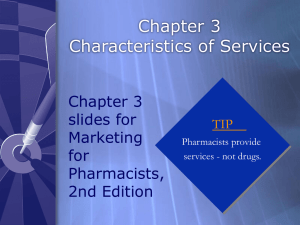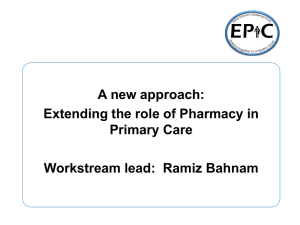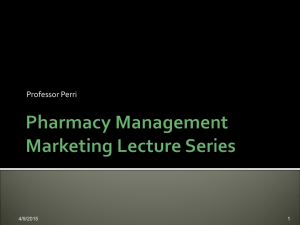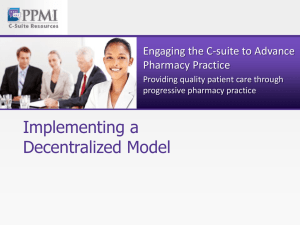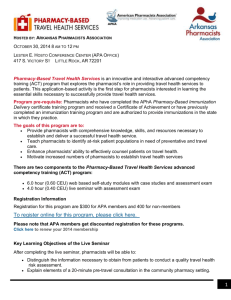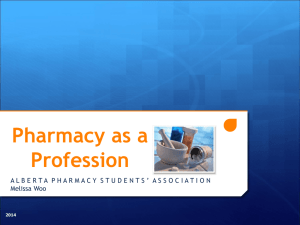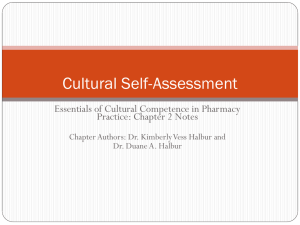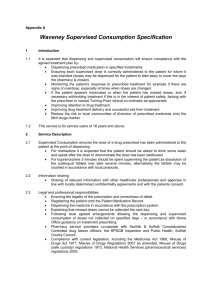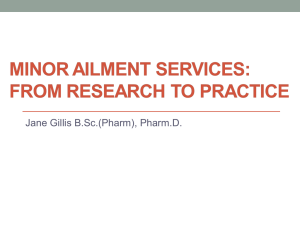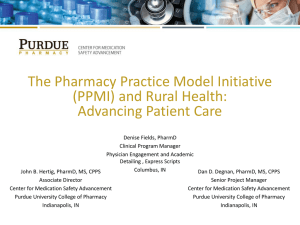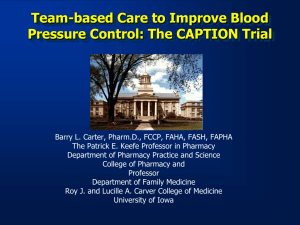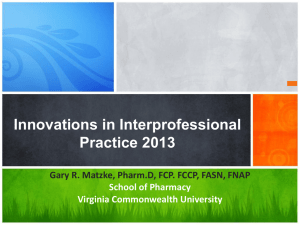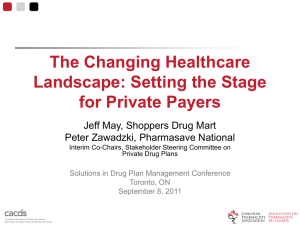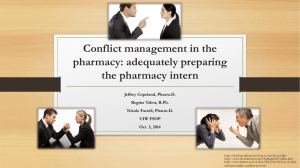RI-Presentation-for-web
advertisement
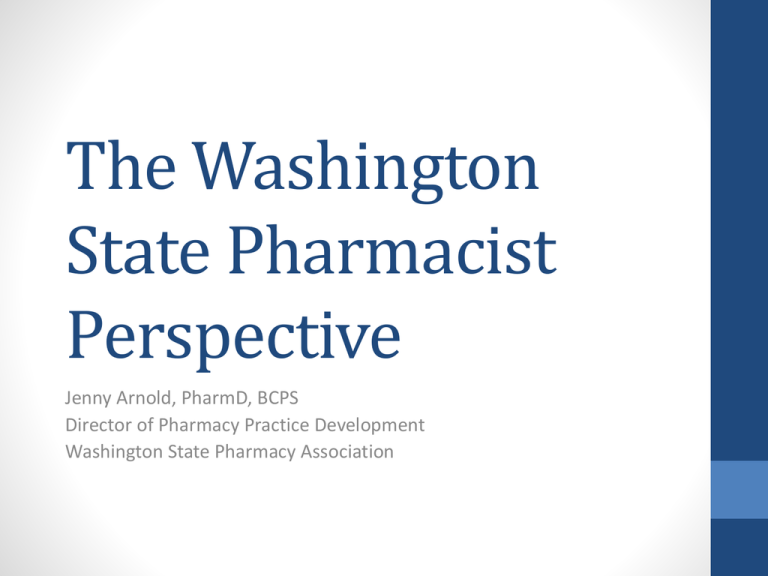
The Washington State Pharmacist Perspective Jenny Arnold, PharmD, BCPS Director of Pharmacy Practice Development Washington State Pharmacy Association Objectives Describe Washington State’s Opiate Deaths Discuss the Scope of Practice of Pharmacy Explain Collaborative Practice Agreements Analyze the challenges of initiating a CPA Examine alternatives for pharmacy involvement Opioid Sales in WA State, Estimated # daily doses sold annually Methadone does not include methadone dispensed by narcotic treatment programs. Methadone data provided by DEA for 2007-2010 included narcotic treatment programs, estimates removing expected NTP use are shown with a dashed line Source: Drug Enforcement Administration Automation of Reports and Consolidated Orders System, data include medications prescribed and dispensed. Data provided to and analyzed by Caleb Banta-Green Alcohol & Drug Abuse Institute, University of Washington Defined Daily Dose utilized from WHO http://www.whocc.no/atcddd/ Outpatient, Inpatient, MMT, • • At the population level rx opiate abuse appears to precede heroin abuse King county data show that 40% of heroin users were “hooked on” Rx opiates first Surpassed traffic fatalities 600 505 Number of deaths 500 400 300 200 100 2008 2007 2006 2005 2004 2003 2002 2001 2000 1999 1998 1997 1996 0 1995 23 Prescription Opioid + alcohol or illicit drug Prescription Opioid +/- Other Prescriptions Source: Washington State Department of Health, Death Certificates, Jennifer Sabel, PhD Medic One Responses 45 serious opiate overdoses per month responded to by SFD in 2011* • Approximately 1:1 Heroin:Rx Opiate 32 cardiac arrest cases per month responded to by SFD in 2010** *268 serious opiate overdoses per our chart abstraction for 6 months in 2011 ** “384 out of hospital cardiac arrest cases treated by SFD in 2010” Drug Caused Deaths, King County WA 180 # of Times Drug Identified 150 120 90 60 30 0 1997 1998 1999 2000 2001 2002 2003 2004 2005 2006 2007 2008 2009 2010 Other Opiate 22 38 29 43 49 63 79 115 127 144 147 154 161 130 Benzo Barb Tricylic MuscRlx GHB 48 53 34 42 46 58 66 76 74 82 77 98 94 79 Alcohol 90 112 70 113 93 132 97 127 68 60 70 71 59 62 111 144 117 102 61 87 62 76 74 71 65 59 50 50 Cocaine 66 69 76 89 49 79 52 92 80 111 86 71 60 46 Methamphetamine 3 3 13 10 5 13 18 18 24 19 18 13 19 15 178 221 197 215 150 195 186 252 240 286 272 257 254 240 Heroin_mophine_opiate Total Source: King County Medical Examiner Public Health- Seattle & King County Drug Caused Deaths, Most Common Pharmaceuticals King County WA 100 90 80 70 60 50 40 30 20 10 0 1997 1998 1999 2000 2001 2002 2003 2004 2005 2006 2007 2008 2009 2010 Methadone 14 20 19 25 24 37 47 67 81 94 82 88 85 65 Antidepressant 30 52 40 42 50 50 78 77 85 76 80 75 80 58 Benzodiazepine 26 31 16 18 19 34 34 42 44 52 43 66 67 57 Oxycodone 1 5 4 12 18 20 14 32 31 44 51 44 58 33 Tri-cyclic anti-depressant 20 36 23 26 21 23 32 28 29 25 18 17 16 16 Source: King County Medical Examiner Public Health- Seattle & King County Opioid Overdose Risk by Average Daily Dose of Prescribed Opioids Received Current average daily dose in morphine equivalents (MED) preceding event 0 mg MED Overdose events, Persons age 18+ (N=9,940) Hazard Ratio (95% Confidence Interval) Rate per 100 person years (%) (# of person years) 1.0 0.047 % (16,980) 1-19 mg MED 2.4 (1.0, 5.5) 0.15 % (14,263) 20-49 mg MED 4.1 (1.5, 11.8) 0.29 % (2,401) 50-99 mg MED 6.1 (1.8, 20.9) 0.44 % (910) 100+ mg MED 22.1 (8.3, 58.5) 1.75 % (628) Pharmacists • Doctor of Pharmacy Degree is now the minimum degree to enter practice. • This entails normally 7 years minimum of education • Pharmacists are the medication experts in healthcare • Post graduate training opportunities include residencies and fellowships. Pharmacists as Mid-level Prescribers o Dependent prescribing o Collaborative Prescriptive Agreements o Similar to PA’s o The laws vary in in each state. Collaborative Prescriptive Agreements o A legal agreement between a prescriber and pharmacist o Agreement must list: o Where and who o Which drugs or diseases o Policies and procedures o Liability insurance o RI Pharmacy Laws Section 25.0 Pharmacist Participating in CPA in RI o A pharmacist participating in CPA must o Have post graduate training/experience o Access to patient information o 5 hours of CE in the area each year Washington State Washington Model o Public Health- Seattle & King County began distributing in February in 2012 o Recruitment via needle exchange o OD prevention and intervention training at Needle Exchange o Narcan prescribing and dispensing by Public Health pharmacist o CPA facilitates this o Police training video recently released based on survey findings Expanded Washington Model o Partnering with Community Pharmacies o Target those either at risk of having, or witnessing an overdose o Utilizing web based patient education and other handouts to limit impact on pharmacist time Opportunities to engage pharmacists o Show the pharmacists what their practices will look like if they prescribe and dispense naloxone o Screening forms o Example CPA o Physician Partners to sign CPAs and refer patients o Education – make the pharmacists the experts in naloxone o Resources and references for questions and further education o Students o Teach this material in schools, so that students come out expecting to do this o Partner with faculty members to include in curriculum Challenges o Evolution of pharmacy practice o Pharmacists can be black and white o Medicaid coverage Other ways pharmacy can help o Stock Naloxone injections or kits o Cash payment o Overdose education, especially to patients on more than 100 morphine equivalents daily o Other Public Health Opportunities o Immunizations o Emergency Response Questions?
